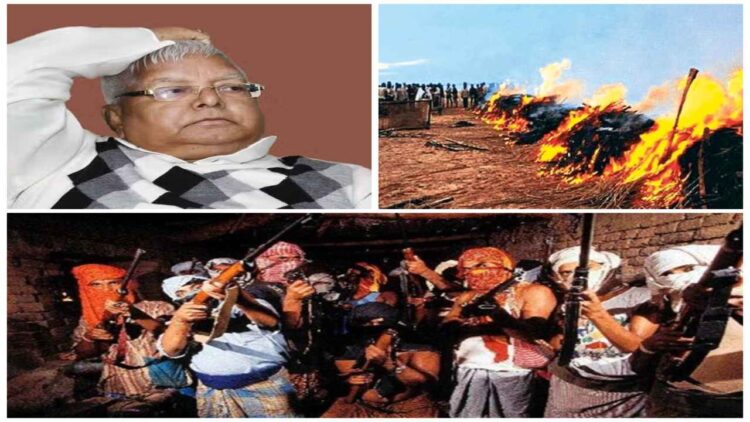Bara Massacre: The 1990s … When the wave of liberalization was going on in India, the country was moving in the new economic direction. People in cities like Delhi, Mumbai were dreaming of changing their luck with advertisements from multinational companies. But at the same time there was a state where the sound of bullets was echoing, not of dreams. Guns used to speak there, the smell of gunpowder was settled in the winds. It was the state of Bihar.
This was the period when Lalu Prasad Yadav was the Chief Minister of Bihar. Ethnic politics was at its peak with slogans like ‘Clean Brown Hair’. Such an alliance of criminals, Naxalites and political patrons was prepared that bleeding on the streets of Bihar had become common. Law and order was laughing and laughing and the common man used to think whether he would be able to return or not. There was a genocide between this turmoil, ethnic conflict and social violence, which shook the whole country, not only Bihar. This was ‘Bara Massacre’ of Bara village in Gaya district. Even today, when the name of that village is taken, the eyes of the old people get filled and the soul of the children trembles.
When Bara village becomes a death ground
12 February 1992 … night time… There was silence everywhere. The people of the village were sleeping peacefully in their homes. But no one knew that this sleep was going to be their last sleep. At around 9 pm, hundreds of Naxalites of CPI Maoist (Male) entered the village. The smell of gunpowder in the air had dissolved and the bullets echoed the village. The Naxalites attacked in a very well planned manner, not in any haste. The target was clean – Bhumihar caste. One by one it was taken out of the houses. Somebody’s hands tied, someone’s feet. The guns on the children’s head, the screams of women … but there was no mercy in the eyes of the Naxalites. 40 people were brutally murdered by taking them to the village. Killing strangled … Such cruelty was not even imagined in the history of modern India.
The orgy of death continued for four hours
This was not a sudden attack, but a well -planned conspiracy of ethnic hatred and social hatred. Till 1:30 pm, the whole village kept screaming, suffering. At the same time, 32 people were engaged in death. The remaining some people died in the hospital. The streets of the village were soaked in blood. The bodies remained lying overnight. The next day when the media reached the morning, only death was captured in cameras. Senior journalists say that he was trembling even after seeing the scene. This was the same period when the Bihar Police was either helpless or involved in collusion. The government was helpless. Lalu Yadav was in power, but his entire focus was on social engineering and caste equation. The administration was paralyzed and there was no sign of justice.
TADA court and justice fight
The case of Bara genocide reached TADA court. 13 people were convicted, in which Kirani Yadav alias Suryadev Yadav became the main accused. The decision came in 2001 and several accused were sentenced to life imprisonment and hanging. But in this battle of justice, the truth should have been found as much as it should have been. The politics of Bihar also saw this incident with the glasses of castes. When the anger of Bhumihars increased, there was also sympathy for the Naxalites between the Dalits and the backward. Lalu Yadav’s government was accused that he did not show interest in tightening the Naxalites, as he did not want to offend his vote bank. The hanging of the four accused was later converted into life imprisonment by the President. 15 years later, the main accused was arrested. The matter was so long that the expectations of the victim families also slowly died.
Genre
Today there is a memorial in Bara village in memory of that horrific night. The names of 40 people are registered on Shilapatt, who sacrificed ethnic politics. The Shilapatt stands as an incomplete question of justice with every passing time. When it is night in the village even today, she floats in the eyes of the elderly. The young generation has grown up listening to this tragedy. But the question is there, is Bihar got justice for it?
Black truth of Lalu Yuga
The Bara Genocide was not just a village incident, but it was a mirror of the black truth of Lalu Yadav in which Bihar had become a stronghold of ethnic violence. In the 1990s, one after the other massacre – Laxmanpur Bathe, Shankar Bigha, Bathani Tola … These were not just names, but of that era. The corpses of law and order were laid under the slogan of Lalu Yadav’s ‘Social Justice’. The police either got entangled in the mathematics of the vote bank or sat down blindly. Ethnic army continued to form, Naxalism flourished, and Bihar continued to be infamous. The Bara Massacre was the most gruesome picture of this entire phase. And today, when we sit in 2025 and remember that event, this question still resonates – did Bihar learn a lesson from that era? Can politics ever become bigger than justice?









